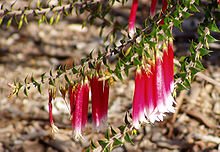Epacris

Epacris is a genus of about forty species of flowering plants in the family Ericaceae. It was formerly treated in a closely related but separate family Epacridaceae, but the various genera within Epacridaceae including Epacris have been revised in their relationships to each other and brought under the common umbrella of the Ericaceae. The genus Epacris is native to eastern and southeastern Australia (southeast Queensland south to Tasmania and west to southeast South Australia), New Caledonia and New Zealand. The species are known as heaths or Australian heaths.
Plants in the genus Epacris are shrubs with simple leaves that are a similar colour on both surfaces and with flowers arranged singly in leaf axils near the ends of the branches, sometimes extending along the branches. Each flower is surrounded by many bracts and five, usually glabrous sepals. The petals are joined to produce a cylindrical or bell-like tube with five lobes on the end. There are five stamens which are mostly enclosed in the tube, and a single style which protrudes from the tube. The fruit is a capsule.[1]
The genus Epacris was first formally described in 1797 by Antonio José Cavanilles, who published the description in Icones et Descriptiones Plantarum.[2] Cavanilles did not specify a type species but in 1983 Edward Groesbeck Voss nominated Epacris longiflora as the lectotype. The genus name (Epacris) is derived from an Ancient Greek word meaning “pointed at the end”.[3]
